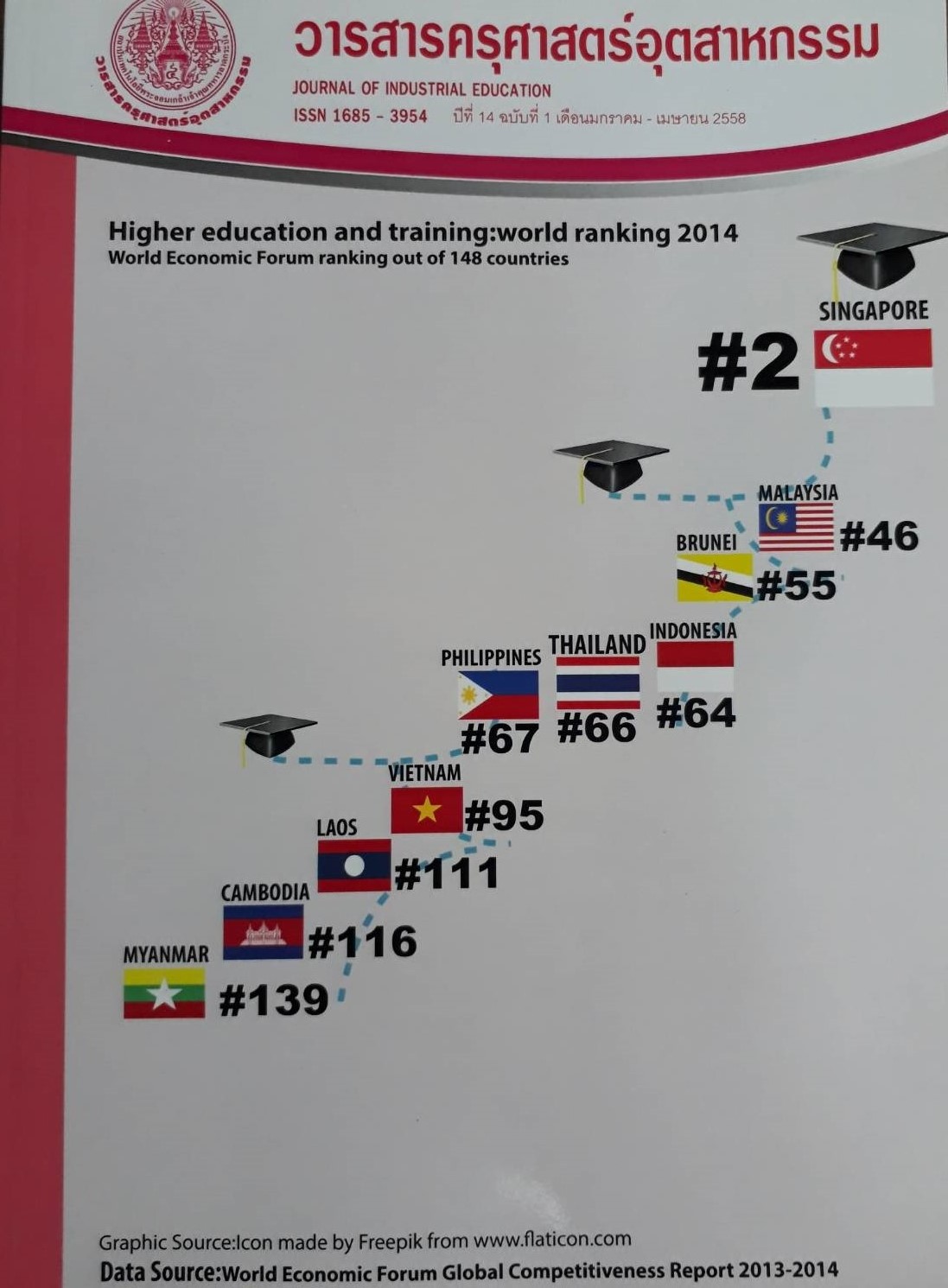Web - Based Training with Embedded Simulator on Industrial Electrical Control System by Programmable Logic Controller (PLC)
Keywords:
Program simulator Logixpro 500, Programmable logic controller (PLC), Web-Based Training, Efficiency, Learning AchievementAbstract
The purposes of this research were to construct and find out effectiveness of the Web–Based Training with Embedded Simulator on Industrial Electrical Control System by PLC, then compared the learning achievement between the experimental group that learned with the Web–Based Training with Embedded Simulator on Industrial Electrical Control System by PLC and the controlled group that learned with the Web-Based Training without Embedded Simulator. In this study, 40 employees from Hair care Tube/Pouch Procter & Gamble manufacturing Thailand Company limited was used as samples by using the sample random sampling method. The sample was divided into two groups with 20 employees for each group. The experimental group learned with the Web–Based Training with Embedded Simulator on Industrial Electrical Control System by PLC while the controlled group learned with the Web-Based Training without Embedded Simulator. The effectiveness of Web–Based Training with Embedded Simulator on Industrial Electrical Control System by PLC was obtained from the experimental group’s learning achievement. Then, the achievement scores of experimental group were compared with the controlled group. The data were analyzed using the independent Sample t-test.
The results of this study was concluded that the effectiveness of the Web–Based Training with Embedded Simulator on Industrial Electrical control system by PLC was at 86.00:85.41 which met the standard criteria at 80:80, and the learning achievement of the subjects who learned with Web–Based Training with Embedded Simulator on Industrial Electrical Control System by PLC was significantly higher then those who learned with the Web-Based training without embedded simulator at .05 level.
References
[2] จรัสศรี รัตตะมาน. 2551. การฝึกอบรมผ่านเว็บ. ค้นเมื่อวันที 5 พฤษภาคม 2556, จาก https://www. bangkokgis.com/webbased_training/aboutus/ aboutus.html
[3] ออมรอน อิเล็กทรอนิคส์. 2552. การใช้งาน PLC ระดับ 1. กรุงเทพฯ: ซีเอ็ดยูเคชั่น.
[4] อรอุมา แก้ววงษา. 2552. คอมพิวเตอร์ช่วยสอน แบบจำลองสถานการณ์. ค้นเมื่อวันที่ 20 พฤษภาคม 2556, จาก htt://learners.in.th/blogs/posts/167762
[5] บุญชม ศรีสะอาด 2545. วิธีการสร้างสถิติ สำหรับการวิจัย. พิมพ์ครั้งที่ 6 กรุงเทพฯ: สุวีริยาสาส์น.
[6] ชัยยงค์ พรหมวงค์และคณะ. 2520. ระบบสื่อการสอน. กรุงเทพฯ : โรงพิมพ์จุฬาลงกรณ์มหาวิทยาลัย.
[7] ล้วน สายยศ และอังคณา สายยศ. 2540. สถิติวิทยาทางการวิจัย. กรุงเทพฯ: สุวีริยาสาส์น.
[8] ธณัฐภรณ์ สนิทมาก. 2555. การพัฒนาบทเรียนผ่าน เครือข่ายอินเทอร์เน็ตเรื่องนิพจน์ และตัวดำเนินการ สำหรับนักเรียนชั้นมัธยมศึกษาปีที่ 5 โรงเรียนแก่งคอย จังหวัด สระบุรี. วารสารครุศาสตร์อุตสาหกรรม, 11(2), น. 146-152.
[9] อัญชลี เตมา. 2551. บทเรียนบนเครือข่ายอินเทอร์เน็ต เรื่องสารเคมีในชีวิตประจำวัน. วิทยานิพนธ์ปริญญา ครุศาสตร์อุตสาหกรรมมหาบัณฑิต สาขาวิชา เทคโนโลยีการศึกษาทางการอาชีวะและเทคนิคศึกษา บัณฑิตวิทยาลัย สถาบันเทคโนโลยีพระจอมเกล้าเจ้าคุณ ทหารลาดกระบัง.
[10] บุญส่ง บุญสืบ. 2551. บทเรียนผ่านระบบอินเทอร์เน็ต เรื่องวงจรระบบนิวเมติกส์เบื้องต้น. วิทยานิพนธ์ ปริญญาครุศาสตร์อุตสาหกรรมมหาบัณฑิต สาขาวิชา เทคโนโลยีการศึกษาทางการอาชีวะ และเทคนิคศึกษา บัณฑิตวิทยาลัย สถาบันเทคโนโลยีพระจอมเกล้า เจ้าคุณทหารลาดกระบัง.
[11] ลัลน์ลลิต ส์บประดิษฐ์. 2555. เปรียบเทียบผลของ การใช้บทเรียนคอมพิวเตอร์มัลติมีเดียที่มีสถานการณ์ จำลองประกอบบทเรียนเรื่อง เศรษฐกิจพอเพียงที่มี ต่อผลสัมฤทธิ์ทางการเรียนกับการสอนปกติ สำหรับ นักเรียนช่วงชั้นปีที่ 3. วารสารวิชาการ คณะศึกษาศาสตร์, 9(2), น. 68-73
[12] สุพจน์ เหล่างาม. 2553. เทคนิคการจำลองสถานการณ์ (Simulation Model). ค้นเมื่อวันที่ 3 มิถุนายน 2556, จาก https://logisticscorner.com/index.
Downloads
Published
How to Cite
Issue
Section
License
"The opinions and contents including the words in papers are responsibility by the authors."
"ข้อคิดเห็น เนื้อหา รวมทั้งการใช้ภาษาในบทความถือเป็นความรับผิดชอบของผู้เขียน"



